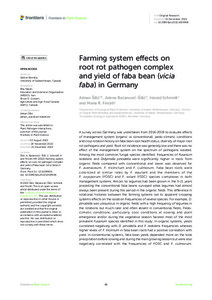| dc.date.accessioned | 2023-02-03T14:38:53Z | |
| dc.date.available | 2023-02-03T14:38:53Z | |
| dc.date.issued | 2022-12-21 | |
| dc.identifier | doi:10.17170/kobra-202302037454 | |
| dc.identifier.uri | http://hdl.handle.net/123456789/14400 | |
| dc.description.sponsorship | Gefördert durch den Publikationsfonds der Universität Kassel | ger |
| dc.language.iso | eng | |
| dc.rights | Namensnennung 4.0 International | * |
| dc.rights.uri | http://creativecommons.org/licenses/by/4.0/ | * |
| dc.subject | fusarium | eng |
| dc.subject | didymella | eng |
| dc.subject | root rot | eng |
| dc.subject | faba bean | eng |
| dc.subject | grain legumes | eng |
| dc.subject | organic agriculture | eng |
| dc.subject | conventional agriculture | eng |
| dc.subject.ddc | 580 | |
| dc.subject.ddc | 630 | |
| dc.title | Farming system effects on root rot pathogen complex and yield of faba bean (vicia faba) in Germany | eng |
| dc.type | Aufsatz | |
| dcterms.abstract | A survey across Germany was undertaken from 2016-2019 to evaluate effects of management system (organic vs conventional), pedo-climatic conditions and crop rotation history on faba bean root health status, diversity of major root rot pathogens and yield. Root rot incidence was generally low and there was no effect of the management system on the spectrum of pathogens isolated. Among the most common fungal species identified, frequencies of Fusarium redolens and Didymella pinodella were significantly higher in roots from organic fields compared with conventional and lower was observed for F. avenaceum, F. tricinctum and F. culmorum. Faba bean roots were colonized at similar rates by F. equiseti and the members of the F. oxysporum (FOSC) and F. solani (FSSC) species complexes in both management systems. Almost no legumes had been grown in the 5-11 years preceding the conventional faba beans surveyed while legumes had almost always been present during this period in the organic fields. This difference in rotational histories between the farming systems led to apparent cropping systems effects on the isolation frequencies of several species. For example, D. pinodella was ubiquitous in organic fields with a high frequency of legumes in the rotations but much rarer and often absent in conventional fields. Pedo-climatic conditions, particularly cool conditions at sowing and plant emergence and/or during the vegetative season favored most of the most prevalent Fusarium species identified in this study. In organic systems, yields correlated negatively with D. pinodella and F. redolens frequencies whereas higher levels of F. tricintum in faba bean roots had a positive correlation with yield. In conventional systems, faba bean yields depended more on the total precipitation before sowing and during the main growing season but were also negatively correlated with the frequencies of FOSC and F. culmorum. Phylogenetic analysis based on the TEF1 alpha locus indicated that the FSSC isolates mainly belonged to the F. pisi lineage. In contrast, the FOSC isolates were placed in 9 different lineages, with a conspicuous dominance of F. libertatis that has until now not been associated with any leguminous host. | eng |
| dcterms.accessRights | open access | |
| dcterms.creator | Šišić, Adnan | |
| dcterms.creator | Baćanović-Šišić, Jelena | |
| dcterms.creator | Schmidt, Harald | |
| dcterms.creator | Finckh, Maria Renate | |
| dc.relation.doi | doi:10.3389/fpls.2022.1009906 | |
| dc.subject.swd | Deutschland | ger |
| dc.subject.swd | Biologische Landwirtschaft | ger |
| dc.subject.swd | Ackerbohne | ger |
| dc.subject.swd | Wurzelfäule | ger |
| dc.subject.swd | Fusarium | ger |
| dc.subject.swd | Pflanzenkrankheit | ger |
| dc.subject.swd | Körnerleguminosen | ger |
| dc.type.version | publishedVersion | |
| dcterms.source.identifier | eissn:1664-462X | |
| dcterms.source.journal | Frontiers in Plant Science | eng |
| dcterms.source.volume | Volume 13 | |
| kup.iskup | false | |
| dcterms.source.articlenumber | 1009906 | |


